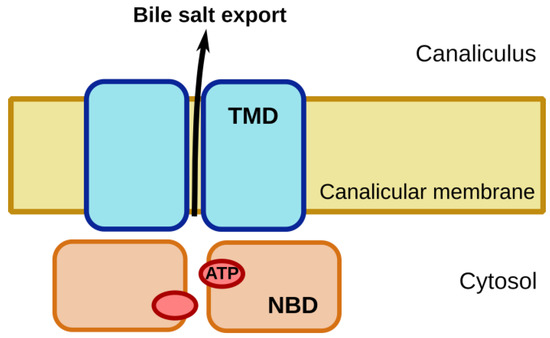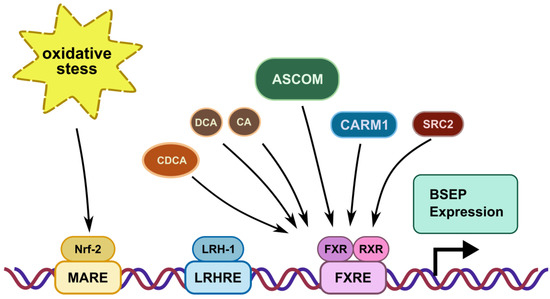The bile salt export pump (BSEP/ABCB11) is responsible for the transport of bile salts from hepatocytes into bile canaliculi. Malfunction of this transporter results in progressive familial intrahepatic cholestasis type 2 (PFIC2), benign recurrent intrahepatic cholestasis type 2 (BRIC2) and intrahepatic cholestasis of pregnancy (ICP).
- BSEP
- ABCB11
- bile salts
- intrahepatic cholestasis
1. Introduction
The ATP-binding cassette (ABC) proteins constitute one of the largest families of membrane proteins. They are universally present in all kingdoms of life. In humans, 48 functional genes encode for ABC proteins, which on the basis of structural and sequence similarity are categorized into seven subfamilies, designated as ABCA through G [1]. Most of these proteins transport substrates across cellular membranes. A functional ABC transporter comprises at least four domains: two transmembrane domains (TMDs) and two nucleotide-binding domains (NBDs), as shown in Figure 1. In the ABCB subfamily, each of the TMDs consists of six membrane-spanning helices. Five of these extend into the cytoplasm to form an expansive intracellular domain. The two TMDs are responsible for substrate binding and translocation. The NBDs form two composite nucleotide-binding sites (NBSs) at their interface, which bind and hydrolyze ATP, and thereby provide the energy for substrate transport. These NBSs are formed by the Walker A and Walker B motifs, as well as the A-, Q- and H-loops of one NBD and the signature motif and D-loop of the other NBD [2,3].

The ABCB subfamily is one of the most diverse groups of ABC proteins, as it includes dimeric half transporters, monomers of which are each composed of one TMD and one NBD, but also full-length transporters, in which all four domains are fused into a single polypeptide chain. The former group comprises the homodimeric transporters ABCB6, ABCB7, ABCB8, ABCB9 and ABCB10, and the heterodimeric transporter ABCB2/ABCB3. The four full-length transporters of the ABCB subfamily are ABCB1, ABCB4, ABCB5 and ABCB11. The heterodimeric ABCB2/ABCB3 and full-length ABCB11 differ from the other members as they contain only one canonical NBS rather than two [4].
2. BSEP/ABCB11: Physiological Role
3. Transcriptional Regulation
BSEP expression is highly regulated by transcriptional mechanisms, and a wide inter-individual variability has been described at the mRNA and protein levels [15].
Expression of BSEP is regulated by a major ligand-activated transcription factor, farnesoid X receptor (FXR, NR1H4), which forms a signaling-competent nuclear receptor heterodimer with the retinoid X receptor (RXR) (Figure 2). Bile acids, such as chenodeoxycholic acid (CDCA), deoxycholic acid (DCA) and cholic acid (CA), are endogenous ligands of FXR with varying potential for activation [16,17,18,19]. Upon ligand binding, the FXR/RXR heterodimer binds to an FXR response element (FXRE) in the promoter region of BSEP, thereby inducing the expression of the transporter [20]. Additionally, components of the activating signal cointegrator-2-containing complex (ASCOM) interact with FXR to enhance BSEP expression. Ananthanarayanan and co-workers [21] showed that the recruitment of ASCOM to the BSEP promoter was disrupted in cholestasis, which was induced by common bile duct ligation. Furthermore, co-activator-associated arginine methyltransferase 1 (CARM1) also regulates FXR/RXR-dependent BSEP transcription [22]. Similarly, steroid receptor co-activator 2 (SRC2) knockout mice showed reduced expression of BSEP [23], indicating its involvement in transcriptional regulation of the transporter.

Hepatocyte-specific liver receptor homolog-1 (LRH-1, NR5A2) is another transcription factor involved in modulation of BSEP expression. LRH-1 plays a supporting role for FXR [24]. The absence of LRH-1 is associated with reduced BSEP expression and an altered BA composition, with disappearance of CA and taurocholic acid (TCA) [25]. BSEP promoter activity is also stimulated by nuclear factor erythroid 2-related factor 2 (Nrf2), a positive transcriptional regulator, which acts as a sensor for oxidative stress. Nrf2 regulates the expression of BSEP, but also that of a number of hepatic phase I and II enzymes and other hepatic efflux transporters such as MRP3 (ABCC3) and MRP4 (ABCC4) [26].
This entry is adapted from the peer-reviewed paper 10.3390/ijms22020784
